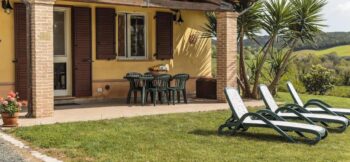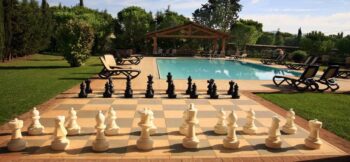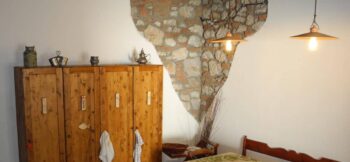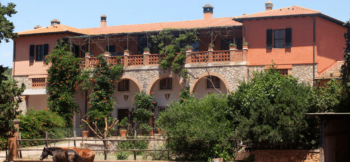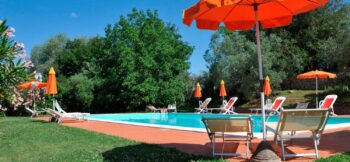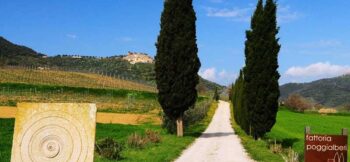
Maremma is an exciting meeting journey to discover the past and also an interesting exploration of modern art.
Let’s start with the past with the Etruscan Park: 11 sites scattered throughout the territory of the province of Grosseto, from the coast to the most central areas; and also includes Follonica, Magliano, Manciano, Saturnia, Montemerano, Massa Marittima, Orbetello, Pitigliano, Scansano, Scarlino and Vetulonia.
Ancient villages that tell, in the narrow alleys, in the fortifications, in the suggestive corners the history from the Etruscan era, to the Roman domination, up to the medieval struggles.
Also worth visiting is the Archaeological and Art Museum of the Maremma in Grosseto at the Orsini Fortress in Sorano.
To switch to contemporary art in the surroundings of Capalbio there is a unique garden of its kind: the Tarot Garden, an artistic park created by Niki de Saint de Phalle in the second half of the last century. Inspired by Gaudi’s Park of Guell in Barcelona. There are 22 large sculptures depicting the Major Arcana of the Tarot cards: the Popess is the most representative work, but we also find Justice, the Sun, the Magician, the Tree of Life, the Devil, the Wheel of Fortune .
ALWAYS CONTINUING WITH CONTEMPORARY ART: “The Garden of Sounds by Paul Fuchs” in Boccheggiano, in the municipality of Montieri, where over 20 sculptures of iron, bronze and copper, placed in particular positions, create sounds in complete harmony with the environment surrounding; “The Garden of Daniel Spoerri”, in the Municipality of Seggiano, where the vast collection of works collected by the Swiss artist is exhibited; also in the area of Monte Amiata, the “Garden of Piero Bonacina – Arte a Parte -” in Montegiovi, in the Municipality of Castel del Piano, an outdoor atelier full of sculptures made of wood, metal, concrete and stone, fully integrated in the landscape.
The combination of multiple materials create the “Return journeys”, the work of bioarchitect Rodolfo Lacquaniti, built in the natural space of the former Buriano padule in Castiglione della Pescaia, finally allowing us to fully immerse ourselves in a surreal path strewn with installations and video art.
>
The Garden of Daniel Spoerri
On the slopes of Monte Amiata, about 80 km from Siena, there is a “garden of paradise”. Daniel Spoerri’s sculpture park, with 87 works by 42 different artists, is a must-visit place to travel with your imagination. Yes, because walking between one sculpture and another one experiences the meaning of the writing placed on the entrance gate: “Hic Terminus Haeret”, “Here borders adhere”.
This contemporary art park, built in Seggiano in the 90s and now a foundation, is in fact a meeting point between ideal creative minds, 15 hectares of land where nature dialogues with the artist’s bronze sculptures and those donated to the park by many other geniuses of international art.
The path, which does not follow a precise definition, can be considered an educational itinerary through which to get in touch with the artistic imagination and the beauty of nature.
The park was designed by the artist Daniel Spoerri, who after living in New York, Simi, Düsseldorf, Paris and other parts of the world, arrived in Tuscany in the nineties, first in Arcidosso and then in Seggiano in 1992. , giving life in the latter place, in his home-laboratory, to the project of a park-museum of sculptures and installations.
The path, within the 16 hectares of park, unravels among large grassy spaces and groves with an apparently random course; the works of contemporary art are arranged in no particular order, integrating and blending into the landscape. In addition to the sculptural path, there is also a botanical path in which many plants are marked with a tag that emphasizes their species and curiosities. Furthermore, for each artist present in the park there is an example of an olive tree typical of the area and known as the “olivastra seggianese”.
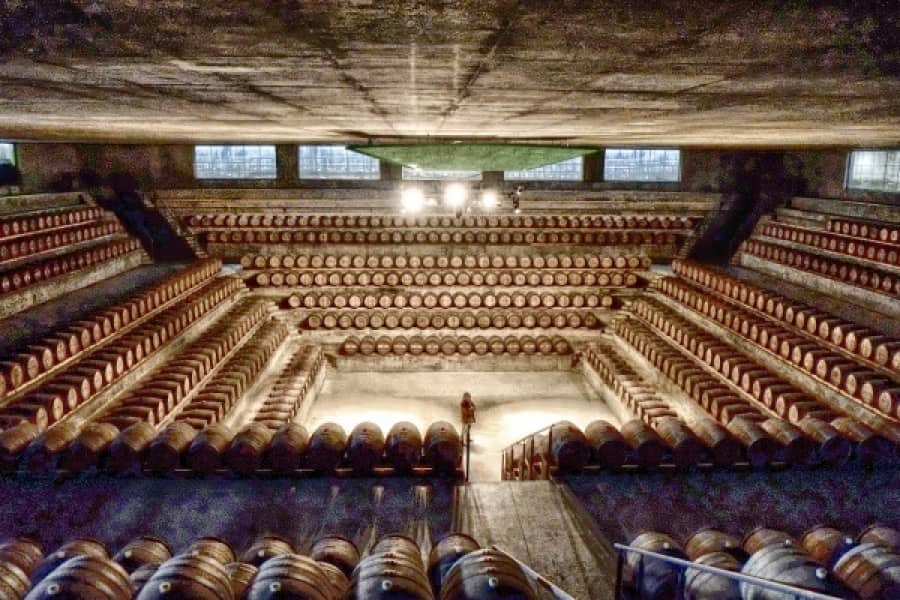
La Cantina Rocca di Frassinello
Elegant and essential, the cellar signed by Renzo Piano has been designed to guarantee the highest quality of the wines
Rocca di Frassinello was born from the idea of replicating the model of excellence of Castellare di Castellina in Chianti Classico in a new territory. The choice was to look at the Maremma, not focusing on the already established territory of Bolgheri, but looking for equally or more qualified land, then identified in the municipality of Gavorrano, in front of the ancient village of Giuncarico.
And it was there that the first, and today unique, Italian-French joint venture project for the production of wine was born: the agreement between Castellare and Domaines Barons de Rothschild brought together Castellare’s experience in the cultivation and vinification of the main grape variety. Tuscan, Sangioveto and that of Chateau Lafite on French vines, Cabernet Sauvignon, Cabernet Franc, Merlot, Shiraz. This is how many award-winning wines were born such as Poggio alla Guardia, Sughere di Frassinello, Rocca di Frassinello and Vermentino.
But Rocca di Frassinello has quickly become the protagonist of a challenge to the most famous wine of Italy, Masseto, in the spirit of the America’s Cup of sailing where those who have the courage can become Challenger to try to snatch the cup from the Defender: to compete for this title , the oenologist Alessandro Cellai created Baffonero, which takes its name from the vineyard of the same name, 100% Merlot. The name tells an entirely Maremma story; in fact, a few steps from the vineyard, the men and dogs of wild boar hunts gather and the Capocaccia has a nickname for the duration of the challenge with the wild boars: they call him Baffonero. Ora Baffonero is a wine that in its name summarizes not only all these stories but, at the same time, the power and the apparently hidden elegance of a unique land like the Maremma.
One of the greatest architects in the world was chosen for the construction of the cellar, Renzo Piano who conceived a cellar with essential shapes, enhancing the functionality of what remains an establishment: the great architect has in fact paid particular attention to its use. of the force of gravity in the winemaking process, in order to guarantee the highest quality of the wines. The design of the cellars usually follows the production order: from the rooms for the reception and selection of the grapes, to the wine cellar, the barrel cellar, up to the warehouse. The architect Piano, on the other hand, revolutionized this conception of spaces by placing the barrel cellar in the center, underground, to keep humidity and temperature naturally stable. A large square of 70 meters by 70 with an immense attic that stands without the support of any column. Around, as in a 20 meter wide frame, all the other functions of the production cycle: the steel vats are distributed on two sides, above each of which, through a manhole accessible from the roof above (the churchyard, he calls it Piano) , during the harvest period the grapes fall by fall.
A Rocca di Frassinello, vin addition to Piano’s work, it is now possible to rediscover the ancient winemaking traditions of the Maremma through a visit to the experiential exhibition “The Etruscans and wine in Rocca di Frassinello” inaugurated in 2015 on a project by the architect Italo Rota. The archaeological finds – many of which vases and wine goblets – found inside the property during the restoration works of the Etruscan Necropolis of San Germano (one of the most important archaeological realities of the territory of the ancient Etruscan city of Vetulonia ) are the background to a narrative path that, traveling through the centuries, makes you rediscover the winemaking traditions of a people who almost 3,000 years ago already cultivated vines in these same lands .
In the Pavillon, the elegant room on the terrace of Rocca di Frassinello, one is instead projected into modern art: in 2014, the company celebrated its first 10 harvests with a collaboration with the American artist and photographer David LaChapelle who , after a stay in Rocca di Frassinello, he wanted to tell with his work “Rapture of the Grape” the respect for wine and its history, humility and the search for perfection that he felt among the people at work in the cellar . The masterpiece of La Chapelle was donated to the winery and is now on permanent display in Rocca di Frassinello.
Fattoria le Mortelle
The Fattoria Le Mortelle is located in Maremma , near Castiglione della Pescaia . It was part of a larger complex called La Badiola, already identified on maps by Leopoldo II in the mid-1800s. The Habsburg-Lorraine, by reclaiming the malarial area of Grosseto, wanted to return the possessions of Badiola and of Alberese strong> guide farms for cattle breeding.
The company belongs to the Antinori family who since 1999 have worked on both the vineyards and the new winery with the belief that the area, still emerging in the Italian wine scene, is highly suited to the production of quality wines and that here they can be expressed at better the characteristics of the terroir and of the cultivated varieties.
The protection and improvement of the cultural, corporate, technical and productive heritage entrusted to us by our predecessors are part of the values deriving from tradition.
Sustainability is not a project, a goal or a strategy for us, but it has always been an integral part of our culture.
A healthy and environmentally friendly approach, in the best agricultural tradition, combined with research and technology, are the fundamental support for a balanced management of our company.
Le Mortelle preserves vast areas of the territory: there are in fact two lakes, the largest of which has an area of 6 hectares. Here the flora and fauna of the territory are preserved and protected.
The new Mortelle winery is located on the top of the slight hill overlooking the estate. The cellar is largely underground, with a view to minimizing the environmental impact possible. it was built using natural materials, taking advantage of the thermoregulation of the rocks present deep in the soil.
The cylindrical hypogeum-shaped structure is arranged on three levels: all the various stages of the wine production cycle are carried out inside it, from receiving the grapes, to vinification, storage and aging in barriques in the basement.
This particular architectural form makes it possible to exploit the best technologies for the production of wine: the entire production cycle takes place “by gravity” following the path from top to bottom, starting from the arrival of the grapes in the raised part, then continuing with the vinification processes in the intermediate part up to the refinement in the most underground part.

Il Giardino dei Tarocchi
In the surroundings of the splendid Capalbio in Maremma there is a garden of unparalleled beauty, the Tarot Garden, created by Niki de Saint de Phalle in the second half of the last century. The Garden houses the large and evocative sculptures by the French artist, depicting the 22 Major Arcana of the Tarot cards.
The eclectic artist drew inspiration from Antoni Gaudì’s Parque Guell in Barcelona, and created a sort of spiritual path with sculptures with symbolic and esoteric meanings that are a metaphor for life. The paths unfold freely through the Garden following the sinuosity of the ground, and on the concrete of the streets are engraved quotes, messages and thoughts that accompany the visitor along his initiatory path. The creation of the Garden stems from Niki’s desire to build a “little corner of paradise where man and nature meet”.
The choice falls on a small land of Mediterranean scrub in the wild Maremma owned by friends, a few kilometers from the charming town of Capalbio in Gravicchio .
Here the artist begins to personally create and build the large sculptures that populate the Garden. The 22 Major Arcana of the Tarot are made of steel covered with concrete with glass, mirrors and colored ceramics. The creation of the Garden engaged the artist for over seventeen years and saw great contemporary artists at work, including Jean Tinguely, the artist’s husband.
The cards represent the artist’s personal vision of the symbolic and esoteric meaning of the Tarot, which she was very fond of. Their arrangement within the garden is suggestive, as if they were narrating the life story of the artist.
The Popess is certainly the most representative work. Depicted as a large “sphinx” woman, this sculpture was Niki’s home when she was working on the Garden. And then Justice, with inside the sculpture of injustice by Jean Tinguely closed by a huge padlock, the Tree of Life, whose branches are snake heads and the stem is covered with inscriptions and drawings by the artist. And again the Devil, the Magician, the Sun, the Wheel of Fortune and the other arcana.
The Tarot Garden is definitely a magical place, a small corner of Paradise in Maremma where art, man and nature truly come together in unison.

Tenuta dell’Ammiraglia
Owned by the Frescobaldi family, it is located in the heart of the Maremma , an area of great potential for the production of high quality wines
The Marquis Frescobaldi family has been dedicated to wine production in Tuscany for over 700 years. The wines were already appreciated in 1500 by Donatello and the main Renaissance artists, arriving on the tables of the Papal Court of Leo X and the King of England Henry VIII.
The Frescobaldi estates are located in some of the most suitable and appreciated areas of Tuscany and represent independent production realities, with dedicated agronomists and oenologists.
The new Tenuta dell’Ammiraglia was inaugurated in 2011 focusing on the uncontaminated and fascinating territory of the Tuscan Maremma.
The estate, owned by the Frescobaldi family, is located in Magliano , in the heart of the Maremma, and is surrounded by vineyards that paint suggestive geometries on the surrounding hills. It is an ideal area for the production of wines, rich in fascinating and still uncontaminated natural beauties. In the summer, the high solar brightness, combined with the sea breezes, creates particularly favorable conditions for the organoleptic qualities of the wines. The combination of all these factors gives the wines of the Ammiraglia an exceptional variety and richness of aromas, unique in Maremma.
The designer cellar of the architect Piero Sartogo is a perfect example of design at the service of production quality and respect for the surrounding environment: it uses natural gravity for the decanting of wine, uses energy from renewable sources and has a covered roof. of plants, to facilitate integration into the territory and create the ideal microclimate in the underlying barrel cellar.




